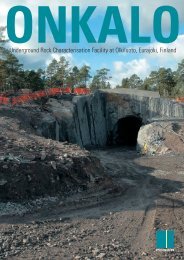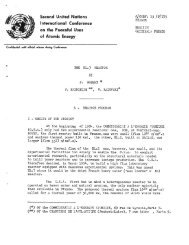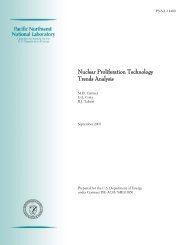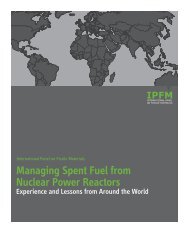Research Report No - International Panel on Fissile Materials
Research Report No - International Panel on Fissile Materials
Research Report No - International Panel on Fissile Materials
You also want an ePaper? Increase the reach of your titles
YUMPU automatically turns print PDFs into web optimized ePapers that Google loves.
when India’s nuclear generating capacity was much smaller. Our estimates are that, in the<br />
absence of uranium imports or cutbacks in India’s nuclear power generati<strong>on</strong>, this<br />
stockpile will be exhausted by 2007.<br />
India is estimated to have total c<strong>on</strong>venti<strong>on</strong>al uranium resources of about 95,500 t<strong>on</strong>s of<br />
uranium, sufficient to supply about 10 GWe installed capacity of PHWRs for forty years<br />
or so. 74 However, the Department of Atomic Energy’s efforts to open new uranium mines<br />
in the country have met with stiff resistance, primarily because of c<strong>on</strong>cerns in the<br />
communities around existing mines about the health impacts of uranium mining and<br />
milling. 75 State governments in Andhra Pradesh and Meghalaya, where DAE has found<br />
significant uranium deposits, have yet to approve new licenses for uranium mining and<br />
milling activities. 76 It is possible that DAE may be able to overcome this resistance. The<br />
most likely new sites are in the districts of Nalg<strong>on</strong>da and Kadapa, Andhra Pradesh, with<br />
projected annual capacities of about 150-200 t<strong>on</strong>s and 250 t<strong>on</strong>s of uranium respectively. 77<br />
If these mines are developed, then India could meet its current domestic uranium needs<br />
for both its nuclear power reactors and weap<strong>on</strong>s program. In the meantime, old mines are<br />
being re-opened and existing mines expanded, including at Jaduguda. 78<br />
In the next few years, the domestic uranium demand for India’s unsafeguarded reactors<br />
will increase further by about 140 t<strong>on</strong>s/year, to 575 t<strong>on</strong>s per year, as the 540 MWe<br />
Tarapur-3 and the 220 MWe Kaiga-3 & Kaiga-4 reactors are completed and begin<br />
operati<strong>on</strong> in 2007. However, the total domestic uranium requirement will begin to<br />
decrease as some of the currently unsafeguarded reactors are opened for inspecti<strong>on</strong> in<br />
2010, 2012 and 2014 as well as the Rajasthan-1 and 2 reactors can be fuelled with<br />
imported uranium (Figure 7). C<strong>on</strong>sequently, if India is able to meet the additi<strong>on</strong>al<br />
demand for domestic uranium until 2010, the availability of uranium imports allowed by<br />
the U.S.-India deal thereafter will give it a growing excess uranium producti<strong>on</strong> capacity<br />
that could be used for weap<strong>on</strong>s purpose.<br />
600<br />
Uranium<br />
(t<strong>on</strong>s)<br />
500<br />
400<br />
300<br />
200<br />
100<br />
0<br />
2006 2008 2010 2012 2014 2016<br />
Year<br />
Figure 7. Estimated annual domestic uranium requirements for unsafeguarded heavy water power reactors. 79<br />
18














